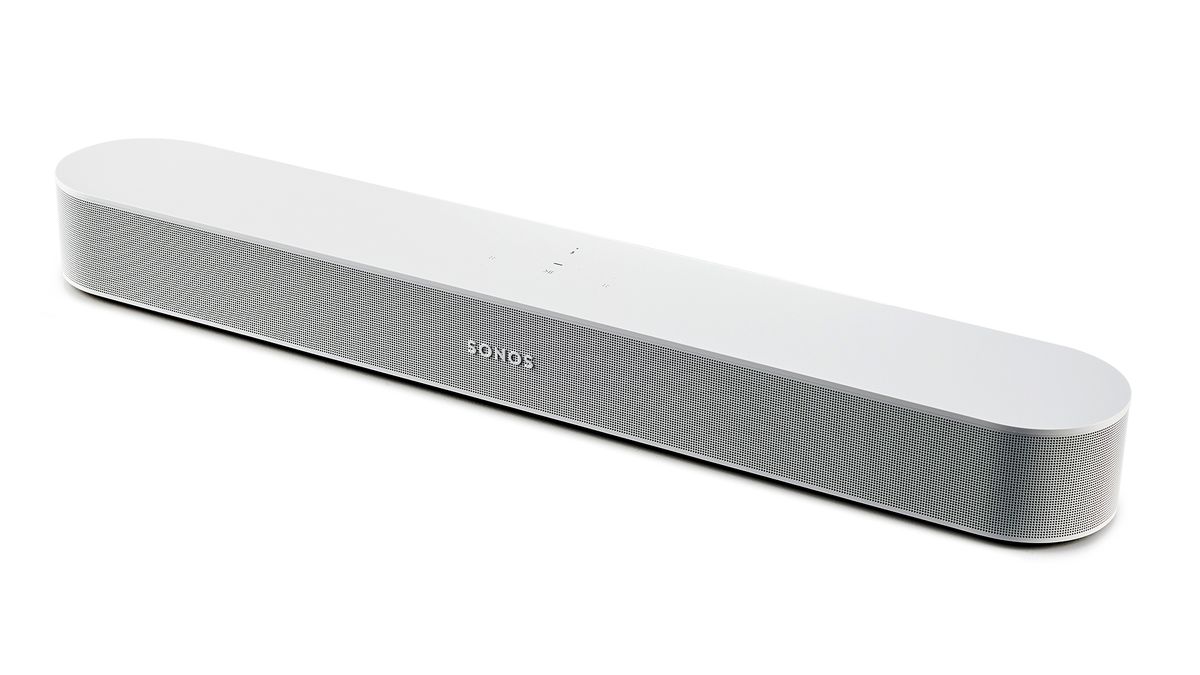While sequels often pail in comparison to their predecessors, the Sonos Beam Gen 2 joins the ranks of The Dark Knight, The Godfather Part II and The Empire Strikes Back as not only a worthy successor but better than its predecessor in every way. That’s no small claim, as the first generation Beam captured our hearts back in 2018 and was adorned with What Hi-Fi? Awards up until this new version launched.
Subsequently, the Beam Gen 2 has taken the place of the first-gen Beam in the Awards lists, and for good reason too. Key to this Sonos sequel’s success is the continuation of what made the first-generation soundbar so appealing, that being a compact and fuss-free design, streamlined functionality and surprising sonic scale and weight, despite its modest footprint.
With the arrival of its larger sibling, the Arc, in 2020, Sonos proved that it can convincingly deliver Dolby Atmos audio in a larger chassis. But we’re a little apprehensive about whether the technology can justify its inclusion in a compact soundbar, especially when, unlike the Arc, there are no upward-firing speakers to be found in the Beam Gen 2.
The Beam is now also the middle child of the Sonos soundbar family, with the arrival of the Sonos Ray in June 2022 and now the Sonos Arc Ultra at the very top of the line-up for 2024 and beyond. That being said, the Ray doesn’t support Dolby Atmos, meaning the Beam Gen 2 is still your entry-level position if you want a Sonos with immersive 3D audio.
In fact, the new Beam’s layout is much the same as its predecessor’s, but the quintet of front-facing drivers are configured into five separate arrays rather than three. When watching Atmos content, two of these arrays are dedicated to reproducing overhead and surround sounds. With enhanced processor power the Sonos Beam Gen 2 uses psychoacoustic HRTF (head-related transfer function) technology to give the impression of height without needing to get vertical.
We’ve experienced Dolby Atmos delivery through processing wizardry before, and the results have been mixed, frequently veering toward synthetic and ineffectual (though the same can also be said of some Dolby Atmos soundbars that actually do have height speakers). So it’s with some trepidation that we unbox the new Sonos Beam.
price“>Price
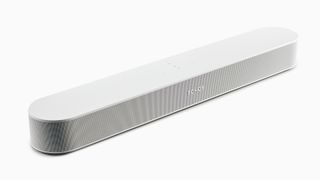
Costing £449 /$449 / AU$699, the Sonos Beam Gen 2 launched at a slightly more expensive price than the original Beam, which was originally £399 / $399 / AU$599. But that difference is very much in line with the company’s increase in the prices across many of its products stemming from the COVID pandemic. Often available at around a 10% discount, the new Beam is the middle product in Sonos’ three-strong soundbar line-up, priced significantly lower than the Arc, which currently costs £899 / $899 / AU$1499, and just above the Ray £279 / $279 / AU$399.
If you want to use Beam Gen 2 in a larger surround system it can be expanded through the addition of two One SL rear speakers (£358 / $358 / AU$538) and, if required, a Sub (£699 / $699 / AU$999).
Other compact Dolby Atmos soundbars in this bracket are thin on the ground. There’s LG’s offering, the bijou but sonically lacklustre Eclair, which has upward drivers but is even more pricey at £700 / $700 / AU$1000. Or there’s Sony’s HT-G700 (£399 / $598 / AU$899), which also has a virtual Atmos effect but is much bigger and, like the Eclair, lacks network connectivity.
Build
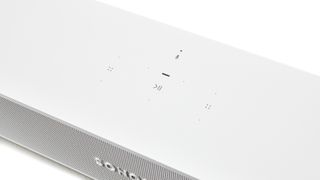
Physically, the new Beam is almost identical to its forebear, with the same dimensions and stylish curved edges. The only outwardly distinguishing feature is the addition of a perforated polycarbonate grille – similar to that of the Sonos Arc – intended to be more durable and easier to clean than the original’s woven fabric finish. Some people will undoubtedly prefer the softer look of the old Beam but we rather like the new Beam’s sleek frontage.
Under the polycarbonate are four front-facing elliptical mid-woofers and an improved centre tweeter that the company claims will produce crisper and clearer dialogue than the original Beam. The drivers are powered by five Class D amplifiers, while three passive radiators provide low-end frequency reinforcement.
Features
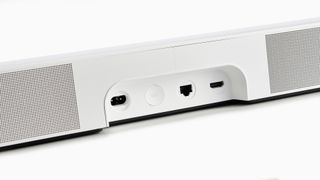
On the top surface are the same touch-sensitive buttons, LEDs and far-field mics for voice control of Amazon Alexa and Google Assistant as on the original Beam. Housed at the rear in the ‘cable cove’ are sockets for power, ethernet and HDMI eARC as well as a connect/reset push button. New for the Beam Gen 2 is a matching of this cove to the finish of the soundbar (matte black or matte white) and the inclusion of colour-complementary HDMI and power cords. Our test sample is white and in our rather grey test room the bright cables draw a bit of attention to themselves, but those with lighter spaces inclined to wall mounting might better appreciate this detail.
Not that many soundbars at this price point come with networking capabilities, but this being a Sonos product, the Beam Gen 2’s ability to integrate into a wireless multiroom system is fundamental to its design. This means that you’ll need the Sonos S2 app to get the most out of your purchase and get it online. While you can control the volume from your TV remote, the app is where you’ll find access to Trueplay (Sonos’ relatively involved room calibration technology) a 2-band EQ as well as confirmation of which audio codec you’re currently receiving. You’ll also need it if you wish to connect it to other Sonos products to build a surround system.
Having wi-fi means you can also stream to the Beam Gen 2 from a handheld device using Apple AirPlay 2, and Spotify Connect is built-in too. There will also be a forthcoming upgrade to add support for Amazon Music Ultra HD audio (for both the Beam Gen 2 and other Sonos models), which will give access to lossless 24-bit/48kHz tracks as well as Dolby Atmos Music.
Sound
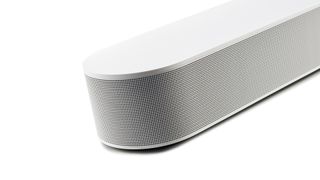
In terms of audio formats, the Beam Gen 2 supports stereo PCM, Dolby Digital, Dolby Digital Plus, Dolby TrueHD, Dolby Atmos (both the Digital+ and TrueHD versions), multichannel PCM and Dolby Multichannel PCM. Decoding for DTS digital surround will be added to this and other Sonos products at a later date but this sadly won’t extend to DTS:X.
Dolby Atmos is really the headline feature of the Beam Gen 2, so can Sonos achieve overhead sound without any height drivers? Well, genuine overhead sounds are perhaps a stretch too far, but there’s more to Dolby Atmos than aeroplanes and helicopters, and the Beam Gen 2 handles the format better than any similarly priced soundbar. Atmos allows a film’s production mixers to place sounds and music as discrete objects within a soundfield, and having the ability to decode it means that users can watch movies with a more compelling soundtrack, whether it be a sedate drama or a car-flipping blockbuster.
When listening to Atmos films with the Beam Gen 2 there’s tangible motion, depth and space, which heightens the drama and sense of immersion. The soundstage is expansive and we try pairing the new Beam both with larger 55-inch and 65-inch screens, as well as a more modest 43-incher, and it enhances the cinematic scale and viewing experience for all three.
In the opening of Roma, in Atmos, the sound design often leads the camera beyond the extremities of the image before the camera pans to catch up with it. The Beam Gen 2 projects the changing sonic perspective incredibly well, with accuracy and clarity. Whether it’s a chirping bird, a car or a voice, there’s remarkable consistency across the complete soundfield, and seamless handover between drivers, which we have to say doesn’t always happen when a Dolby Atmos soundbar has upward drivers to contend with.
Sonos Beam Gen 2 tech specs
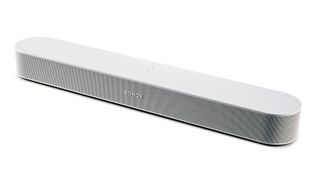
Connections 1*eARC
ARC/eARC eARC
Sound format support Dolby Atmos DP / Dolby Atmos True HD / Dolby Digital / Multichannel PCM/ Dolby Multichannel PCM / stereo PCM
Bluetooth No
WiFi Yes
AirPlay 2 Yes
Chromecast No
Finishes Black matte, white matte
Voice control Works with Amazon Alexa and Google Assistant.
Dimensions (hwd) 7 x 65 x 10cm
Weight 2.8 kg
In the incredibly stress-inducing scene in which the father painstakingly parks his car in the family’s narrow driveway while smoking a cigarette and blasting classical music, the rapid editing from interior to exterior, above the car to below the bumper, is expertly matched by the Beam Gen 2’s rendering of space and dynamics. And despite the lack of upward drivers, there’s a remarkably real sense of the engine idling away up above in the low shots.
At the very end of the film, where the housekeeper wades deep into the sea to save the family’s children, the new Beam copes well with the thunderous crashing waves, which we’ve heard other soundbars with separate subs fail to grapple with. Its projection is not quite as impressive as that of the Sonos Arc, where there is much more of a feeling of the rising water enveloping the viewer, but it’s still a very competent and more subtle interpretation than that of the Beam Gen 1.
So transparent and clear is the improved central tweeter that when watching Bohemian Rhapsody, the harmonic distortion on Freddy Mercury’s vocal from the original recordings of Live Aid, which typically isn’t that noticeable, is very apparent and actually starts to become a bit irritating. But this doesn’t detract from the fantastic job the Beam Gen 2 does in representing the Atmos sound design as the camera’s viewpoint roams about the stage and each instrument or monitor comes into sonic focus. The sound of each instrument feels natural and unprocessed, no matter where it sits in the shot, and when the camera flies over the audience there’s a real wide-sweeping sensation of movement and expanse.
To test the Beam’s handling of detail and timbre we stream Amy Winehouse’s Tears Dry On Their Own with its lush ’60s-style arrangement. In the sparse opening, featuring only woodblocks, celeste and wind players, the transients are sparkling and well defined while the vocal is open and present. In the low mids, the brass feels rich and, although we’d love to hear more of the baritone sax’s full-throated range, the lower notes are well handled if a little curtailed. That said there’s still a greater depth of tone here than you get from the Beam Gen 1, which has more of a hands-off approach to any frequencies beyond its reach.
As the second verse begins and the accompaniment becomes denser, every instrument has sonic space to breathe and ornamentation, such as the clarinet weaving around the vocal line, comes nicely to the fore.
With Frightened Rabbit’s Old Old Fashioned, the Beam Gen 2 keeps up with the frantic strumming of the acoustic guitar paired with the heavy, deadpan kick drum. The timing isn’t perfect but the soundbar keeps the low end taut enough to maintain coherence with the nimble higher frequencies.
Swapping to the eclectic overload of Split Enz’s Sweet Dreams, there’s plenty of velocity and drive to capture the funkier elements, particularly the bass, with a strong leading edge. Despite the vocal sitting lower in the mix, it still sings out and, unlike the original Beam, we feel more comfortable pushing the volume without veering into harshness.
Verdict
The Beam Gen 2 not only lives up to the high bar set by its predecessor but exceeds it by a margin that more than justifies its new feature set and higher cost. The decision by Sonos to use processing power and forward-facing drivers to recreate Dolby Atmos has paid off with a more capable and effective handling of the format than many more expensive soundbars with upward-firing drivers. The Sonos Beam Gen 2 is simply the best Dolby Atmos soundbar at this price point, and it elevates itself yet further with its streaming smarts, compact design and expert handling of motion, depth and space.
Atmos aside, it sounds incredible, reaching deeper than the Beam Gen 1 with more refinement, a warmer treble, and wider dynamic range. Where the Beam Gen 1 might skim over certain complex sounds the Gen 2 has a greater capacity to take them on, consistently resulting in a richer, more nuanced and varied listening experience.
First reviewed: October 2021. Updated review: November 2024.
SCORES
MORE:
Sonos Beam Gen 3 preview: 4 things we want from the next budget Dolby Atmos soundbar
See our Sonos Arc review
Check out our review of the Sony HT-G700
Best soundbars: the best TV speakers you can buy






